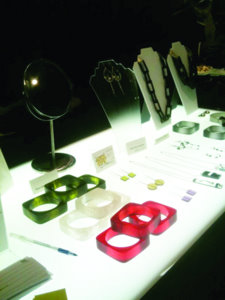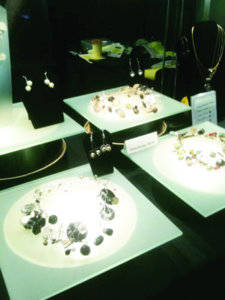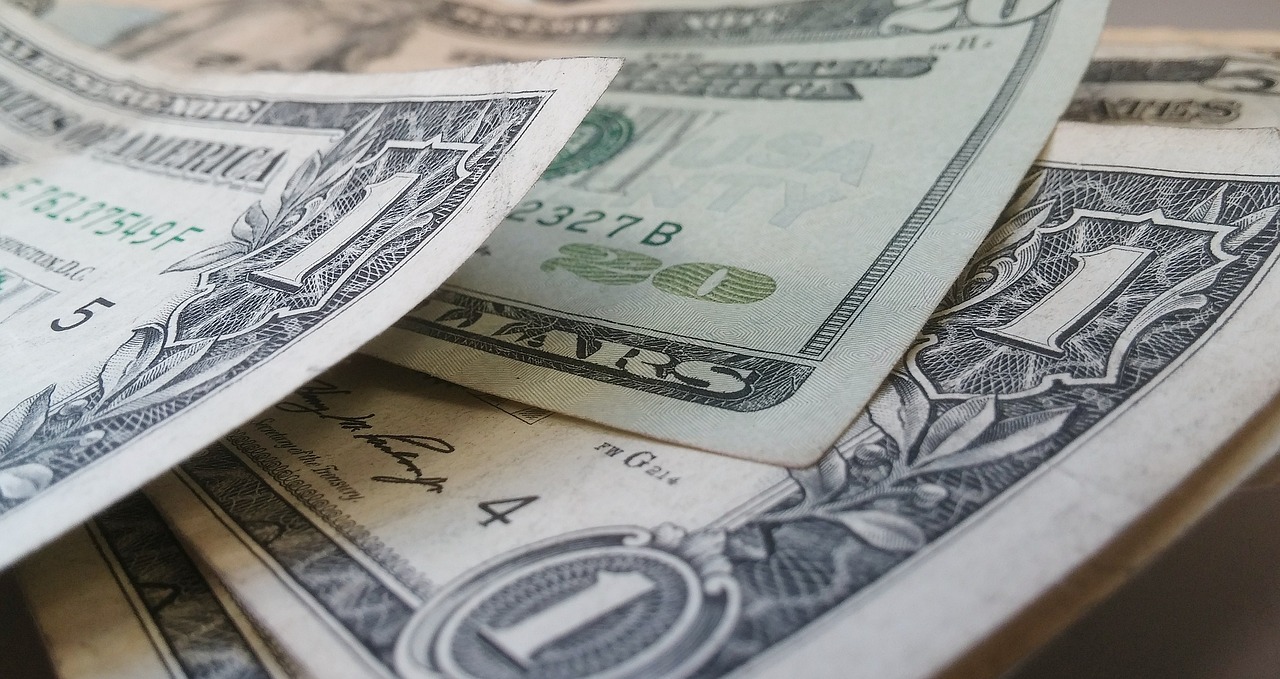It takes approximately 1,000 watts of bright white light to illuminate a 10-by-10-foot space and properly knock out the shadows and make the art for sale dazzle.
It continues to amaze me that many artists do not utilize this valuable tool in visual merchandising to its full advantage. At the shows I attend, most artists simply do not have enough light—they don’t have enough fixtures and bulbs to do the job. Keeping in mind the 300 to 400 watts from the overhead lights in the exhibit hall or natural light from nearby windows, chances are good that you need more.
Hall lighting issues
Some halls are bright and well-illuminated, while others are dark as a tomb and you need to rent or provide lights to lighten up your booth. The light quality in exhibit halls is often lacking as well. Many use low-cost lighting, the quality of which will distort the colors of your creations (perhaps an additional white light in your display will keep your colors true).
Light placement
Another common problem I see at shows is the placement of the lights. Light from most bulbs does not travel well, meaning the farther the bulbs are from the objects you are trying to illuminate, the less bright the objects will appear. Getting those bulbs closer to the objects will yield a brighter, more attractive display.
A general rule is that if the light fixture is over the customers’ heads when they are looking at the objects, then the lights are in the right place. In doing this, you have eliminated the possibility that the customer’s head or body would come between the light source and the art (casting a shadow over your work).
Poor light placement can also result in the bulbs shining into the customers’ eyes. When you look into your booth, there should be no blinding bulbs visible.
See what the customer sees
After you have set up your display, walk out into the aisle and see what the customers see. Are you blinding them as they walk by or are your lights properly focused so the art is shining back at them?
 Properly illuminated booth spaces are not something the customer really notices or ever comments on, but if there aren’t enough appropriately placed lights, it will have a negative affect on your sales. If customers cannot see it, they will not buy it. Don’t make them work to see your work.
Properly illuminated booth spaces are not something the customer really notices or ever comments on, but if there aren’t enough appropriately placed lights, it will have a negative affect on your sales. If customers cannot see it, they will not buy it. Don’t make them work to see your work.
Quality lighting
Good lighting always makes me want to pull out my camera and take a picture. That is literally what happens in the customers’ heads—they want to remember what they are seeing. And to do so, they will usually pick it up for closer examination. When customers touch what you make, they are much more likely to buy it. Touch is the first step in owning something and if you can get to this step, your sales will go up.
Good lighting renders your products so alluring that customers cannot resist touching them. This, in turn, gives you subliminal permission to talk to them. Customers with your work in their hands will listen more intently to what you are saying about it.
I recently attended the new One of a Kind Show and Sale in New York City and was treated to a delightful group of artists. There were many exciting booths at this show, and mostly artists I had never met before. I was specifically looking for examples of good lighting and I found some excellent examples.
Keep in mind that good lighting doesn’t need to be expansive, it just needs to show off your work to its best advantage and make people want to touch (and buy).
An excellent example of low-cost but highly effective booth lighting at the show was in the booth of Lemon Park (www.lemonpark.ca). Using simple underlighting, they dramatically displayed their amazing art/fashion jewelry line (see photo at _____). (figure 1) Notice how the light coming up from the bottom makes these resin bracelets and earrings look like candy! They are almost irresistible to the customer—who could not touch these?
Another example of their excellent display and lighting choices were the bottom-lit low pedestals, in multiple levels on their tables. (figure 2) These low-tech risers were created with a ring (made of cardboard, metal or plastic) and painted to give a finished look. A piece of frosted glass or Plexiglas was placed on top, with a simple light source underneath the glass (inside the ring).
These lights could be low-voltage halogen, LEDs or even inexpensive battery-operated lights if electrical power isn’t available (as is the case at many outdoor shows). This underlighting technique made all of the transparent gemstones in the lovely necklaces glow! Notice also the black boxes in the upper right. Each of these boxes had a light inside it to make the jewelry visually “pop.” The lighting was stunning and drew almost everyone who walked by into the space. So alluring and accessible, this was one of the best booths I have discovered in years.
Another fine example of using lighting to amplify his art was Bruce R. MacDonald of Burlington, Vt. He uses both white and colored light to make his arresting stainless steel wall art come alive. His work is large and impressive, just what art should be in these times. By using not only ample overhead white light, MacDonald employs a spectral colored LED device that is battery operated at the show, (figure 3) but he also will supply and install them in the clients’ home if they desire.
Perhaps this is not as low-tech as the “Lemon Park” example, but it gave the art a lot of bang for the buck. His cold silvery grey stainless piece came completely alive when an element of colored lighting was added. See figure 4. More examples of fine lighting can be found on his website: www.brmdesign.com.
Lemon Park and Bruce MacDonald both had fantastic booths that displayed their art to its best advantage, each method being just right for the art it was illuminating. When I stood back and evaluated it, once again I was reminded that good display and lighting have nothing to do with how much money you spend—they are the result of how creative you are!
Ultimately, be as creative with your lighting and your display as you are when making your work. Any effort you put to this end will draw more people into your booth, which will always increase your sales.






